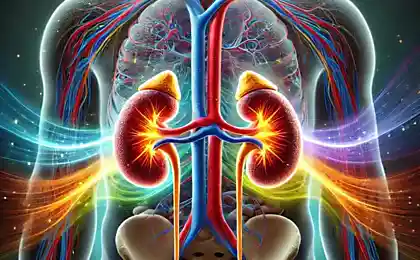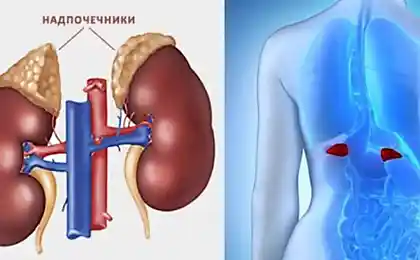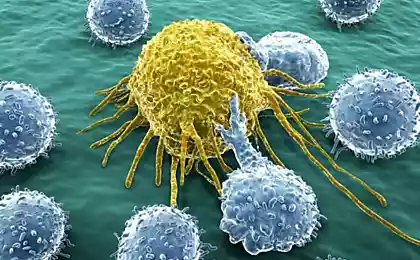827
The known as lipoprotein lipase: How does metabolism
Our diet, stress and physical activity are associated with many complex interactions. Today I want to tell you about one interesting and important enzyme, which is the crossroads between nutrition, stress, and physical activity level. This will allow us to better understand how it works in General metabolism and how to better organize your health regimen. So, get acquainted, her Majesty, known as lipoprotein lipase (LPL), and below I'll tell you why you might want to know about this interesting and unique molecule. Most rich known as lipoprotein lipase the heart, skeletal muscle and adipose tissue and it plays a different role. Where exactly will the fat? It depends on the activity of lipoprotein lipase in specific tissues.
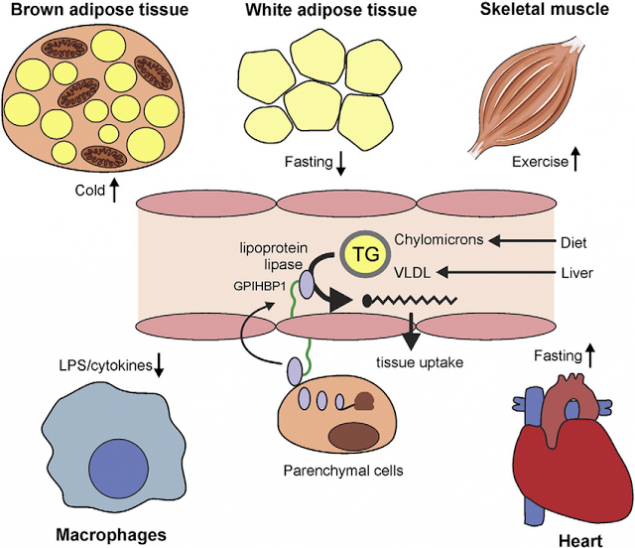
What does the known as lipoprotein lipase? The activity of lipoprotein lipase directly proportionally the ability of tissues to capture fats from the blood and break them down. Lipolysis occurs mainly within the capillaries of adipose tissue, skeletal muscle and cardiac muscle. Fats from the blood goes into the cells and used in different ways: in adipocytes for fat synthesis and deposition, and in the myocardium and skeletal muscle, they are oxidized, forming ATP required for these tissues. The fats in the plasma present in the composition lipoproteidnyi particles. Most of these particles containing the greatest amount of fats are too large to penetrate from the capillaries into the intercellular liquid, so the fat cells can't grab them directly. There is an interesting mechanism to overcome this difficulty. Adipocytes produce the enzyme known as lipoprotein lipase, which hydrolyzes fats in lipoproteidnyi particles to free fatty acids, which can penetrate into the extracellular fluid and reach the adipocytes. As needed known as lipoprotein lipase in the capillaries, it is exported from the adipocytes into endothelial lining of the capillaries of adipose tissue. Then known as lipoprotein lipase contained in the endothelial cells of adipose tissue, can interact lipoproteidnyi particles. The known as lipoprotein lipase is produced by the connective tissue cells and is then transferred to the inner wall of the capillaries. There she breaks down the transport form of fats in the form of chylomicrons. If the blood vessels in fat tissue, fats go into savings, and if it is a muscle known as lipoprotein lipase, is weight loss. Therefore, the more LPL in muscle cells, the stronger is the process of burning, but the more LPL in adipose tissue, the stronger the process of fat accumulation. The activity of LPL determines lipid profile (ratio of good and bad cholesterol.
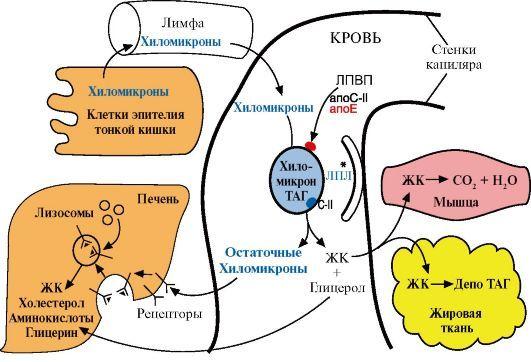
Blood Mature chylomicrons (transport form of fat) are subjected to the action of the enzyme lipoprotein lipase that is localized on the surface of vascular endothelium, mainly in adipose and muscle tissues. This enzyme "know" chylomicrons, interacting with the apos-II, which activates this enzyme. The known as lipoprotein lipase hydrolyzes fats in the composition of chylomicrons to glycerol and free fatty acids. Glycerol is transferred to liver, and fatty acids can either be oxidized in the tissues as a source of energy or to be deposited in the form of TAG fatty tissue. The ability of the enzyme to break down triglycerides not unlimited, so the excess accumulation of plasma VLDL may impair the removal of the chylomicrons. The relative content of lipoprotein lipase in adipose tissue compared to muscle is higher among women than men correlates with higher HDL cholesterol and lower concentrations of VLDL observed in women. In men, the amount of enzyme in adipose tissue increases with regular consumption of alcohol, and systematic physical exercises increase the content of enzyme in skeletal muscle, and both, accompanied by increased levels of HDL cholesterol ("good" cholesterol). Food and known as lipoprotein lipase When food (eating) activates the regulatory molecule ANGPTL8, and the axis of ANGPTL8–ANGPTL3 that inhibits the activity of LPL in the heart and muscles, improving the availability of fat for fat tissue, where activity. At the same time, the more and more you eat, the more often activates LPL in adipose tissue and the weaker activity of LPL in muscles. Food abstinence is the opposite and fats (triglycerides) are sent to the muscles. Relatively recently, it was found that this enzyme dramatically aktiviziruyutsya for any extended restrictions (longer than two to three days) in the flow of calories (for example, when dieting for weight loss) that occurs in the period after the next half-starved diet, whether accompanied by complete fasting or not. Has a value and the concentration of fatty acids in the blood. In addition, in the capillaries of adipose and other tissues fats in VLDL and chylomicrons are hydrolyzed under the action of lipoprotein lipase. This enzyme "know" on the surface of lipoproteins protein apos-II, activated them and hydrolyzes TAG included in lipoproteins to glycerol and fatty acids. In different tissues are isoforms of LP-lipase with different values of Ksh. In the capillaries of adipose tissue, the value of Km is higher — hence, this enzyme is actively working with high concentrations of lipoproteins in the blood in absortivity period; muscle CABG is below — hence the muscle can utilize fatty acids released from lipoproteins, and lower their concentration in the blood. A special role for LPL plays a insulin. Thus, the storage of fat in adipose tissue — the so-called Deposit of fat occurs in the absorptive period, when the increase in the ratio of insulin — glucagon. The effect of insulin on the activity of the enzyme is to increase the transcription, then processing of the enzyme by the adipocyte and its export to the endothelium. It is a slow process, it takes about 3-4 hours. In adipose tissue esterification of fatty acids is also stimulated by products of the glycerol-triphosphate by glycolysis, which is also regulated by insulin. Ie., insulin stimulates and the capture and accumulation of circulating fats in the adipose tissue. Another possible mechanism of deposition of fat in adipose tissue lipogenesis. This process is similar to that of the liver, also stimulates insulin. Insulin activates the synthesis of LPL and its exposure (transfer!) on the surface of the capillaries in adipose tissue. Insulin also increases fatty acid synthesis in the liver. Once these extra fatty acids are converted to triglycerides, they are captured by lipoproteins (e.g. VLDL, very low density lipoproteins) and released into the blood, and are looking for a place for their storage. So far, so good, because triglycerides cannot be absorbed by fat cells. So, although in your blood can be rather of triglycerides, you actually won't accumulate fat. until it is not known as lipoprotein lipase into. As soon as it is activated by insulin, known as lipoprotein lipase breaks down these triglycerides into absorbable fatty acids that are quickly and easily absorbed by fat cells, again converted there into triglycerides and remain in the fat cells. How are LPL, insulin and the metabolism of cholesterol? The most common dyslipidemia in the metabolic syndrome is a lipid triad: the combination of hypertriglyceridemia, low HDL and HL increase the fraction of small dense LDL particles. The presence of such a triad in patients without type 2 diabetes increases the risk of developing coronary heart disease by 3-5 times. It's simple. Thus, insulin regulates the rate of synthesis of very low density lipoproteins by the liver. With increasing concentration there is a growth of synthesis of these lipoproteins, as in conditions of hyperinsulinemia, glucose is metabolized into fatty acids. In the presence of the insulin resistance known as lipoprotein lipase, the enzyme regulating the elimination of fatty acids, is resistant to the effects of insulin, and therefore their elimination is slowed. Growth synthesis and slowing down the elimination of fatty acids lead to increased concentrations of very low density lipoproteins and triglycerides in the blood plasma. Lowering activity of lipoprotein lipase is accompanied by a decrease in the content of lipoproteins of high density as they are formed in the body by hydrolysis of lipoproteins of very low density. Moreover, it is shown that hyperinsulinemia directly contributes to the catabolism of high density lipoproteins. Thus, the development of immunoresistance and hyperinsulinemia is accompanied by the development of dyslipidemia, characterized by increased concentrations of very low density lipoproteins and triglycerides and low concentrations of high density lipoprotein in plasma. Physical activity and known as lipoprotein lipase , whether we Like it or not, but if we sit for 8 hours, then increased activity at another time we can pay for any seat damage. And American doctors ten years ago even coined the term: the syndrome of early death sedentary (Sedentary Death Syndrome). To maintain the activity of LPL is much more important to sit less than actively engage. If you sit more than 5-6 hours a day, then the sport will not be able to offset the negative manifestations seat. Lack of exercise in any form (often redundant seat) dramatically reduces the activity of lipoprotein lipase in muscle. So, they lose more than 75% of its ability to bind and break down fats. This occurs because 90% to 95% loss of activity of LPL. Interestingly, much of the activity of LPL is associated with large muscles of the legs! Short and medium duration physical activity is not significant on the activity of LPL. So, 4 hour walk with a long of inactivity does not help to increase the level of LPL in muscles. One day inactivity significantly inhibits gene expession of LPL in muscles.
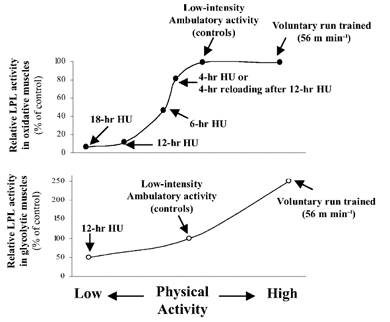
The solution is simple – more work standing up! Besides, in a vertical position burned one and a half times more calories than sitting. For example, the difference between the four hours spent in the upright and sitting position is 240 calories. If you sit for more than an hour, then reduced level of the enzyme lipoprotein lipase, which calories are deposited in fat, not muscle. From a physiological point of view, it is assumed that no local muscle contractions due to the stationary lifestyle leads to a weakening of the work of lipoprotein lipase in skeletal muscle and glucose uptake. At the same time, in the standing position, is the isometric contraction of the antigravity (postural) muscles. When muscles are reduced a little, reduced the content of the enzyme lipoprotein lipase (LPL), which burns fat and reduces the accumulation of fatty deposits. People should not only seek to increase physical activity — walk more, exercise, but also to try to reduce the time spent in the seat. Only breaking up long periods of sitting in any traffic, we speed up metabolism and regulate the physiological processes in the body. It is essential to avoid prolonged sitting in one place, and be sure to take breaks to stand, walk, stretch
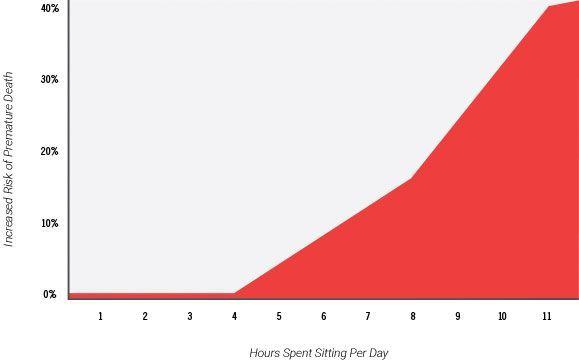
Researchers in the Australian Diabetes, Obesity and Lifestyle Study made a discovery: it turns out that there is a relationship between metabolic and breaks for physical exercise in sedentary work. Breaks can be changing positions from sitting to vertical or standing position for easy ' walk. Scientists also found a link between a large number of breaks in sedentary work and changes in waist size, body mass index, triglyceride content and blood glucose. If the control of food and portion sizes can enable lower weight, despite the lack of physical activity, according to the latest research, the minimum physical programs may not be sufficient to overcome the negative effects of a sedentary lifestyle on health. Fat intake in trained and untrained obese young men before and after 8 weeks a short physical exercise, 4 days a week (Koskela and Hanninen, unpublished data).

The known as lipoprotein lipase, the key hormones and physique One of the main mechanisms of the influence of sex hormones on adipose tissue is a direct regulation of the activity of lipoprotein lipase, the main enzyme regulating the accumulation of triglycerides in adipocytes. In women of reproductive age, it is stimulated by estrogens in the adipose tissue of the thighs and buttocks, where the activity of said enzyme is higher than in subcutaneous fat of abdominal region. In this regard, method obesity does not affect health and affects only the external appearance of a woman. The result is accumulation of lipids to ensure adequate supplies of energy during pregnancy and lactation. After menopause, the activity of lipoprotein lipase is reduced, and the adipocytes in the femoral-gluteal region are decreasing in size, i.e. there is a relative redistribution of body fat. Cortisol is the hormone that greatly affects the distribution of fat in both sexes. Cortisol behaves as glucocorticoid receptor, stimulating lipoproteinlipazou. The infamous fat on the internal organs in the abdomen consists mainly of fat cells called visceral adipocytes. In visceral adipocytes are more glucocorticoid receptors than other fat cells. In subcutaneous fat is much less glucocorticoid receptors. And in fat cells on the thighs and upper legs of glucocorticoid receptors is even less. This means that cortisol makes to delay the fat in the abdominal region, and less in other parts of the body, and even less in the legs.That is why stress is one of the key reasons for visceral (internal) fat. Testosterone and GH inhibit the known as lipoprotein lipase (LPL) expression and stimulates lipolysis (breakdown of fat). The action of cortisol is mediated through the glucocorticoid receptor, and the action of testosterone via the androgen receptor, the density of which is more expressed in the inner fat layer. Therefore, the decline of testosterone is a significant risk of visceral obesity. The fat cells testosterone inhibits the consumption of lipids and the activity of lipoprotein lipase (LPL) and stimulates lipolysis by increasing the number of lipolytic β-adrenergic receptors.
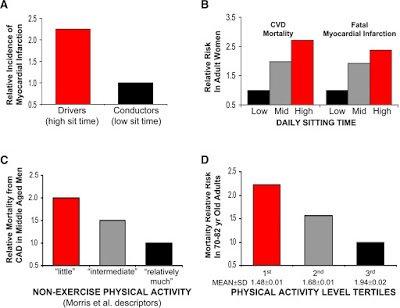
The effect of different conditions on the activity of LPL in muscle and in subcutaneous fat.
The condition of LPL adipose Muscle LPL Post (food abstinence) ↓ ↑ Food Excess of carbohydrates ↑↑ ↑ Excess fat ↑ ±↑ Physical activity Variable ±↑ Insulin ↑↑ ↓ Catecholamines (epinephrine) ↓ unchanged thyroid Hormones ↓ in rat, ↑ man ↓ Estrogens ↓ ↑ Testosterone ↓ ↑ Obesity ↑↑ (/cell) ±↓ Diabetes ↓ ↓ Conclusions: 1. Frequent meals and long starvation diets trigger weight gain. 2. The reduction in seats more effective than regular training. Work standing up! 3. Clean long intervals between meals help fat burning. 4. Any stress impairs the activity of LPL. Learn to work with it! published
P. S. And remember, just changing your mind - together we change the world! ©
Source: //www.beloveshkin.com/2017/04/lipoproteinlipaza-kuda-pojti-zhiru.html

What does the known as lipoprotein lipase? The activity of lipoprotein lipase directly proportionally the ability of tissues to capture fats from the blood and break them down. Lipolysis occurs mainly within the capillaries of adipose tissue, skeletal muscle and cardiac muscle. Fats from the blood goes into the cells and used in different ways: in adipocytes for fat synthesis and deposition, and in the myocardium and skeletal muscle, they are oxidized, forming ATP required for these tissues. The fats in the plasma present in the composition lipoproteidnyi particles. Most of these particles containing the greatest amount of fats are too large to penetrate from the capillaries into the intercellular liquid, so the fat cells can't grab them directly. There is an interesting mechanism to overcome this difficulty. Adipocytes produce the enzyme known as lipoprotein lipase, which hydrolyzes fats in lipoproteidnyi particles to free fatty acids, which can penetrate into the extracellular fluid and reach the adipocytes. As needed known as lipoprotein lipase in the capillaries, it is exported from the adipocytes into endothelial lining of the capillaries of adipose tissue. Then known as lipoprotein lipase contained in the endothelial cells of adipose tissue, can interact lipoproteidnyi particles. The known as lipoprotein lipase is produced by the connective tissue cells and is then transferred to the inner wall of the capillaries. There she breaks down the transport form of fats in the form of chylomicrons. If the blood vessels in fat tissue, fats go into savings, and if it is a muscle known as lipoprotein lipase, is weight loss. Therefore, the more LPL in muscle cells, the stronger is the process of burning, but the more LPL in adipose tissue, the stronger the process of fat accumulation. The activity of LPL determines lipid profile (ratio of good and bad cholesterol.

Blood Mature chylomicrons (transport form of fat) are subjected to the action of the enzyme lipoprotein lipase that is localized on the surface of vascular endothelium, mainly in adipose and muscle tissues. This enzyme "know" chylomicrons, interacting with the apos-II, which activates this enzyme. The known as lipoprotein lipase hydrolyzes fats in the composition of chylomicrons to glycerol and free fatty acids. Glycerol is transferred to liver, and fatty acids can either be oxidized in the tissues as a source of energy or to be deposited in the form of TAG fatty tissue. The ability of the enzyme to break down triglycerides not unlimited, so the excess accumulation of plasma VLDL may impair the removal of the chylomicrons. The relative content of lipoprotein lipase in adipose tissue compared to muscle is higher among women than men correlates with higher HDL cholesterol and lower concentrations of VLDL observed in women. In men, the amount of enzyme in adipose tissue increases with regular consumption of alcohol, and systematic physical exercises increase the content of enzyme in skeletal muscle, and both, accompanied by increased levels of HDL cholesterol ("good" cholesterol). Food and known as lipoprotein lipase When food (eating) activates the regulatory molecule ANGPTL8, and the axis of ANGPTL8–ANGPTL3 that inhibits the activity of LPL in the heart and muscles, improving the availability of fat for fat tissue, where activity. At the same time, the more and more you eat, the more often activates LPL in adipose tissue and the weaker activity of LPL in muscles. Food abstinence is the opposite and fats (triglycerides) are sent to the muscles. Relatively recently, it was found that this enzyme dramatically aktiviziruyutsya for any extended restrictions (longer than two to three days) in the flow of calories (for example, when dieting for weight loss) that occurs in the period after the next half-starved diet, whether accompanied by complete fasting or not. Has a value and the concentration of fatty acids in the blood. In addition, in the capillaries of adipose and other tissues fats in VLDL and chylomicrons are hydrolyzed under the action of lipoprotein lipase. This enzyme "know" on the surface of lipoproteins protein apos-II, activated them and hydrolyzes TAG included in lipoproteins to glycerol and fatty acids. In different tissues are isoforms of LP-lipase with different values of Ksh. In the capillaries of adipose tissue, the value of Km is higher — hence, this enzyme is actively working with high concentrations of lipoproteins in the blood in absortivity period; muscle CABG is below — hence the muscle can utilize fatty acids released from lipoproteins, and lower their concentration in the blood. A special role for LPL plays a insulin. Thus, the storage of fat in adipose tissue — the so-called Deposit of fat occurs in the absorptive period, when the increase in the ratio of insulin — glucagon. The effect of insulin on the activity of the enzyme is to increase the transcription, then processing of the enzyme by the adipocyte and its export to the endothelium. It is a slow process, it takes about 3-4 hours. In adipose tissue esterification of fatty acids is also stimulated by products of the glycerol-triphosphate by glycolysis, which is also regulated by insulin. Ie., insulin stimulates and the capture and accumulation of circulating fats in the adipose tissue. Another possible mechanism of deposition of fat in adipose tissue lipogenesis. This process is similar to that of the liver, also stimulates insulin. Insulin activates the synthesis of LPL and its exposure (transfer!) on the surface of the capillaries in adipose tissue. Insulin also increases fatty acid synthesis in the liver. Once these extra fatty acids are converted to triglycerides, they are captured by lipoproteins (e.g. VLDL, very low density lipoproteins) and released into the blood, and are looking for a place for their storage. So far, so good, because triglycerides cannot be absorbed by fat cells. So, although in your blood can be rather of triglycerides, you actually won't accumulate fat. until it is not known as lipoprotein lipase into. As soon as it is activated by insulin, known as lipoprotein lipase breaks down these triglycerides into absorbable fatty acids that are quickly and easily absorbed by fat cells, again converted there into triglycerides and remain in the fat cells. How are LPL, insulin and the metabolism of cholesterol? The most common dyslipidemia in the metabolic syndrome is a lipid triad: the combination of hypertriglyceridemia, low HDL and HL increase the fraction of small dense LDL particles. The presence of such a triad in patients without type 2 diabetes increases the risk of developing coronary heart disease by 3-5 times. It's simple. Thus, insulin regulates the rate of synthesis of very low density lipoproteins by the liver. With increasing concentration there is a growth of synthesis of these lipoproteins, as in conditions of hyperinsulinemia, glucose is metabolized into fatty acids. In the presence of the insulin resistance known as lipoprotein lipase, the enzyme regulating the elimination of fatty acids, is resistant to the effects of insulin, and therefore their elimination is slowed. Growth synthesis and slowing down the elimination of fatty acids lead to increased concentrations of very low density lipoproteins and triglycerides in the blood plasma. Lowering activity of lipoprotein lipase is accompanied by a decrease in the content of lipoproteins of high density as they are formed in the body by hydrolysis of lipoproteins of very low density. Moreover, it is shown that hyperinsulinemia directly contributes to the catabolism of high density lipoproteins. Thus, the development of immunoresistance and hyperinsulinemia is accompanied by the development of dyslipidemia, characterized by increased concentrations of very low density lipoproteins and triglycerides and low concentrations of high density lipoprotein in plasma. Physical activity and known as lipoprotein lipase , whether we Like it or not, but if we sit for 8 hours, then increased activity at another time we can pay for any seat damage. And American doctors ten years ago even coined the term: the syndrome of early death sedentary (Sedentary Death Syndrome). To maintain the activity of LPL is much more important to sit less than actively engage. If you sit more than 5-6 hours a day, then the sport will not be able to offset the negative manifestations seat. Lack of exercise in any form (often redundant seat) dramatically reduces the activity of lipoprotein lipase in muscle. So, they lose more than 75% of its ability to bind and break down fats. This occurs because 90% to 95% loss of activity of LPL. Interestingly, much of the activity of LPL is associated with large muscles of the legs! Short and medium duration physical activity is not significant on the activity of LPL. So, 4 hour walk with a long of inactivity does not help to increase the level of LPL in muscles. One day inactivity significantly inhibits gene expession of LPL in muscles.

The solution is simple – more work standing up! Besides, in a vertical position burned one and a half times more calories than sitting. For example, the difference between the four hours spent in the upright and sitting position is 240 calories. If you sit for more than an hour, then reduced level of the enzyme lipoprotein lipase, which calories are deposited in fat, not muscle. From a physiological point of view, it is assumed that no local muscle contractions due to the stationary lifestyle leads to a weakening of the work of lipoprotein lipase in skeletal muscle and glucose uptake. At the same time, in the standing position, is the isometric contraction of the antigravity (postural) muscles. When muscles are reduced a little, reduced the content of the enzyme lipoprotein lipase (LPL), which burns fat and reduces the accumulation of fatty deposits. People should not only seek to increase physical activity — walk more, exercise, but also to try to reduce the time spent in the seat. Only breaking up long periods of sitting in any traffic, we speed up metabolism and regulate the physiological processes in the body. It is essential to avoid prolonged sitting in one place, and be sure to take breaks to stand, walk, stretch

Researchers in the Australian Diabetes, Obesity and Lifestyle Study made a discovery: it turns out that there is a relationship between metabolic and breaks for physical exercise in sedentary work. Breaks can be changing positions from sitting to vertical or standing position for easy ' walk. Scientists also found a link between a large number of breaks in sedentary work and changes in waist size, body mass index, triglyceride content and blood glucose. If the control of food and portion sizes can enable lower weight, despite the lack of physical activity, according to the latest research, the minimum physical programs may not be sufficient to overcome the negative effects of a sedentary lifestyle on health. Fat intake in trained and untrained obese young men before and after 8 weeks a short physical exercise, 4 days a week (Koskela and Hanninen, unpublished data).

The known as lipoprotein lipase, the key hormones and physique One of the main mechanisms of the influence of sex hormones on adipose tissue is a direct regulation of the activity of lipoprotein lipase, the main enzyme regulating the accumulation of triglycerides in adipocytes. In women of reproductive age, it is stimulated by estrogens in the adipose tissue of the thighs and buttocks, where the activity of said enzyme is higher than in subcutaneous fat of abdominal region. In this regard, method obesity does not affect health and affects only the external appearance of a woman. The result is accumulation of lipids to ensure adequate supplies of energy during pregnancy and lactation. After menopause, the activity of lipoprotein lipase is reduced, and the adipocytes in the femoral-gluteal region are decreasing in size, i.e. there is a relative redistribution of body fat. Cortisol is the hormone that greatly affects the distribution of fat in both sexes. Cortisol behaves as glucocorticoid receptor, stimulating lipoproteinlipazou. The infamous fat on the internal organs in the abdomen consists mainly of fat cells called visceral adipocytes. In visceral adipocytes are more glucocorticoid receptors than other fat cells. In subcutaneous fat is much less glucocorticoid receptors. And in fat cells on the thighs and upper legs of glucocorticoid receptors is even less. This means that cortisol makes to delay the fat in the abdominal region, and less in other parts of the body, and even less in the legs.That is why stress is one of the key reasons for visceral (internal) fat. Testosterone and GH inhibit the known as lipoprotein lipase (LPL) expression and stimulates lipolysis (breakdown of fat). The action of cortisol is mediated through the glucocorticoid receptor, and the action of testosterone via the androgen receptor, the density of which is more expressed in the inner fat layer. Therefore, the decline of testosterone is a significant risk of visceral obesity. The fat cells testosterone inhibits the consumption of lipids and the activity of lipoprotein lipase (LPL) and stimulates lipolysis by increasing the number of lipolytic β-adrenergic receptors.

The effect of different conditions on the activity of LPL in muscle and in subcutaneous fat.
The condition of LPL adipose Muscle LPL Post (food abstinence) ↓ ↑ Food Excess of carbohydrates ↑↑ ↑ Excess fat ↑ ±↑ Physical activity Variable ±↑ Insulin ↑↑ ↓ Catecholamines (epinephrine) ↓ unchanged thyroid Hormones ↓ in rat, ↑ man ↓ Estrogens ↓ ↑ Testosterone ↓ ↑ Obesity ↑↑ (/cell) ±↓ Diabetes ↓ ↓ Conclusions: 1. Frequent meals and long starvation diets trigger weight gain. 2. The reduction in seats more effective than regular training. Work standing up! 3. Clean long intervals between meals help fat burning. 4. Any stress impairs the activity of LPL. Learn to work with it! published
P. S. And remember, just changing your mind - together we change the world! ©
Source: //www.beloveshkin.com/2017/04/lipoproteinlipaza-kuda-pojti-zhiru.html

















